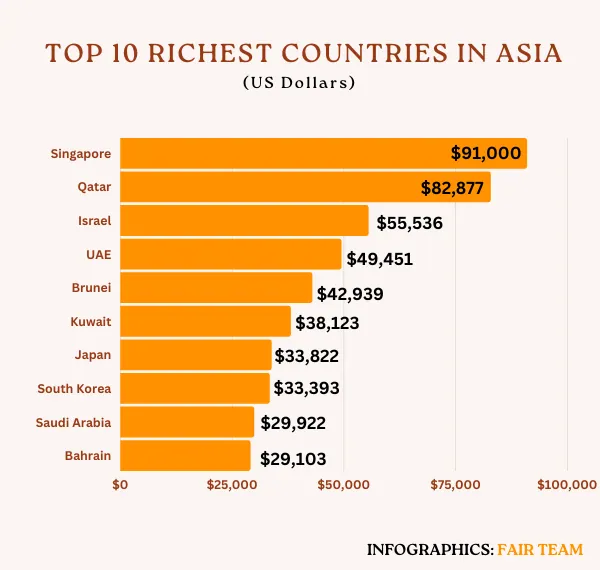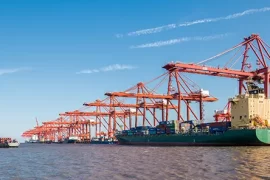Asia is a continent of immense diversity, with a wide range of cultures, languages, and economic systems. However, there are a few countries that stand out in terms of their economic prosperity and wealth. In this article, we will take a look at the top 10 richest countries in Asia in 2024 and examine their economies and industries in more detail.
Ranking criteria for the top 10 richest countries in Asia in 2024
In our assessment of the top 10 wealthiest countries in Asia, we have given significant consideration to the GDP per capita as a key indicator. This metric quantifies a nation’s economic output per individual by dividing its GDP by the total population. By employing this measure, we can gain valuable insights into the relative prosperity and economic well-being of each country on our list.
List of the top 10 richest countries in Asia
The top 10 richest countries in Asia in 2024, ranked by GDP per capita, are Singapore, Qatar, Israel, the United Arab Emirates, Brunei, Kuwait, Japan, South Korea, Saudi Arabia, and Bahrain.
Singapore, the richest country in Asia
Singapore is the richest Asian country, with a per capita GDP of $91,000 (2023). It is also the 10th largest economy in Asia.
The country boasts a highly developed market economy, historically driven by extensive entrepôt trade. Between 1965 and 1995, Singapore achieved remarkable average annual growth rates of around 6 percent. Its GDP growth forecast for 2023 is in the range of 0.5% to 2.5%.
Singapore is one of the few countries worldwide to hold an AAA credit rating from the major credit rating agencies, demonstrating its fiscal strength and stability. The city-state attracts significant foreign investment due to its strategic location, skilled workforce, low tax rates, advanced infrastructure, and strong stance against corruption. Singapore ranks as the world’s 4th most competitive economy in 2023, according to the International Institute for Management Development’s World Competitiveness Ranking. Additionally, the country holds the world’s eleventh-largest foreign reserves.
Singapore is also known as a tax haven for the wealthy due to its low tax rates on personal income, tax exemptions on foreign-based income, and capital gains. This has attracted affluent individuals, including high-profile figures like Brett Blundy and Eduardo Saverin. According to the 2024 Index of Economic Freedom , Singapore has the freest economy in the world.
Singapore ranks 9th on the Human Development Index, reflecting its high level of development in areas such as education, healthcare, and income equality. The Ministry of Social and Family Development oversees various initiatives aimed at supporting families and individuals, including financial assistance, healthcare subsidies, tuition support for children, and other benefits to enhance the well-being of citizens. Singapore is one of the top 10 safest countries in Asia. It is also the 10th best country to live in the world.
Key features
GDP ( nominal): $515.548 billion (30th in the world)
Area: 734.3 km2
Population: 5,637,000
Qatar, the 2nd wealthiest country in Asia
The second richest Asian country Qatar’s per capita GDP is $82,877 ( 2023).
Qatar’s economy is heavily dependent on natural gas exports, which account for over 50% of the country’s GDP. The country holds the 3rd largest proven natural gas reserves in the world. Qatar’s LNG export stands at 127.9 billion cubic meters per year ( 2021). However, the country’s liberal trade policies and its emerging role as a regional financial center have fostered private-sector expansion beyond the realms of the oil and gas sectors. The government has also invested heavily in infrastructure projects, including the construction of stadiums and other facilities related to the FIFA World Cup 2022.
Qatar is also a major player in the aviation industry, with Qatar Airways being one of the fastest-growing airlines in the world. It contributes 4.9% to the country’s GDP.
The Qatar Investment Authority (QIA), Qatar’s sovereign wealth fund, was established in 2005 to diversify the country’s economy beyond oil and gas. With approximately $475 billion in assets under management as of September 2023, QIA has invested significantly in global entities such as Barclays Bank, Credit Suisse, Harrods, Porsche, Volkswagen, and the Paris Saint-Germain soccer team. It also holds extensive real estate holdings in London, including The Shard and parts of Canary Wharf.
In terms of human development, Qatar ranks very high ( 2021 HDI score is .855). The high score suggests a long and healthy life, access to knowledge, and a decent standard of living for the Qatari citizens.
Key features
GDP (nominal): $221.369 billion (2023)
Area: 11,581 km2
Population: 2,795,484
Israel, the 3rd wealthiest country in Asia
Israel’s per capita GDP is $55,536. The country has a highly developed economy that is focused on high-tech industries, particularly in the fields of software, telecommunications, and biotechnology. Israel is also a major player in the diamond industry, with a significant proportion of the world’s diamonds being cut and polished in the country.
According to the 2023 Index of Economic Freedom, Israel has the freest economy in the Middle East.
Israel belongs to the very high human development category with an HDI score of .919 (2021).
Key features
GDP (nominal): $539 billion (2023)
Area: 20,770 km2
Population: 9,750,560
United Arab Emirates (UAE)
The UAE’s per capita GDP is $49,451 (2023). The country’s economy is highly diversified, with a strong focus on tourism, finance, and trade.
Dubai, one of the UAE’s largest cities, is a major global hub for finance and tourism, with the world’s tallest building, the Burj Khalifa, and one of the world’s busiest airports, Dubai International Airport.
The UAE is also a major player in the oil and gas industry, with significant reserves and a highly developed infrastructure.
The UAE belongs to the very high human development category with an HDI score of .911 (2021).
Key features
GDP (nominal): $498.98 billion (2023)
Area: 83,600 km2
Population: 9,282,410
Brunei
Brunei’s per capita GDP is $42,939 (2023). The country’s economy is heavily dependent on oil and gas exports, which account for over 90% of its GDP. Brunei is a member of the Organization of the Petroleum Exporting Countries (OPEC) and has significant oil and gas reserves. The government has invested heavily in infrastructure projects, including the construction of a new airport and the expansion of the oil and gas industry.
Brunei belongs to the very high human development category with an HDI score of .829 (2021).
Key features
GDP (nominal): $18.464 billion (2023)
Area: 5,765 km2
Population: 460,345[ 2020]
Kuwait
Kuwait is the sixth richest country in Asia, with a per capita GDP of $38,123 (2023). The Kuwaiti dinar holds the distinction of being the world’s most valuable currency unit in terms of its exchange rate.
The country’s economy is heavily dependent on oil exports, which account for over 90% of its GDP. Kuwait is a member of OPEC and has significant oil reserves. It has 10% of the world’s oil reserves.
Kuwait belongs to the very high human development category with an HDI score of .831 (2021).
Key features
GDP (nominal): $183.576 billion (2023)
Area: 17,818 km2
Population: 4,294,621 [2022]
Japan, the 7th richest Asian country
Japan’s per capita GDP is $33,822.
Japan has the world’s third-largest economy by nominal GDP, ranking after the United States and China, and the fourth-largest economy by PPP. Additionally, Japanese yen is the world’s third-largest reserve currency, following the US dollar and the euro. I
The country is a major player in global trade, ranking as the fourth-largest exporter and importer in 2021. Key export products include motor vehicles, iron and steel products, semiconductors, and auto parts.
Japan belongs to the very high human development category with an HDI score of .925 (2021).
Key features
GDP (nominal): $6.139 trillion (2023)
Area: 377,975 km2
Population: 124,840,000
South Korea
Another richest Asian country South Korea’s per capita GDP is $33,393. It ranks 8th in the list of the wealthiest countries in Asia in 2024.
South Korea has a mixed economy and ranks as the 11th largest GDP at nominal and the 14th largest GDP by purchasing power parity in the world. From the 1960s to the late 1990s, South Korea experienced rapid economic growth, earning it the nickname “Miracle on the Han River.” It recorded one of the fastest rises in average GDP per capita in the world between 1980 and 1990. The country is estimated to experience a 1.5% growth in 2023.
South Korea is the most industrialized member country of the OECD. South Korean brands, such as LG Electronics and Samsung, have gained international recognition for their quality.
The country belongs to the very high human development category with an HDI score of .925 (2021).
Key features
GDP (nominal): $1.721 trillion (2023)
Area: 100,363 km2
Population: 51,966,948
Saudi Arabia, the 9th wealthiest country in Asia
Saudi Arabia’s per capita GDP is $29,922. It is the largest economy in the Middle East.
The country’s economy is heavily dependent on oil exports, which account for over 40% of its GDP. Saudi Arabia is the largest exporter of petroleum. The country has the fifth-largest gas reserves in the world. Saudi Arabia is a member of OPEC and has significant oil reserves.
Additionally, Saudi Arabia earns an annual revenue of approximately $10-15 billion from the Hajj pilgrimage and $4-5 billion from the Umrah pilgrimage.
The Saudi government has invested heavily in infrastructure projects, including the construction of a new high-speed rail network and the expansion of the oil and gas industry.
Saudi Arabia belongs to the very high human development category with an HDI score of .875 (2021).
Key features
GDP (nominal): $1.061 trillion[ (2023)
Area: 2,149,690 km2
Population: 35,939,806
Bahrain, the 10th richest Asian country
Bahrain is the 10th richest country in Asia, with a per capita GDP of $29,103 (2023). The country’s economy is highly diversified, with a strong focus on finance, trade, and tourism.
According to the 2023 Index of Economic Freedom, Bahrain has a moderately free economy.
Bahrain’s economic growth is set to ease to 2.7 percent in 2023, with non-oil GDP predicted to rise by 3.2 percent. This increase is attributed to fiscal consolidation, elevated interest rates, and a base effect from the robust growth experienced in 2022. Looking ahead, stability is projected, with growth settling around 2.7 percent over the medium term, commented IMF following its 2023 Article IV mission to the Kingdom.
Bahrain is home to the Bahrain International Circuit, which hosts the Formula One Bahrain Grand Prix, as well as a number of other major international events.
Bahrain belongs to the very high human development category with an HDI score of .875 (2021).
Key features
GDP (nominal): $44.16 billion (2023)
Area: 786.5 km2
Population: 1,463,265
Summary of the top 10 richest countries in Asia
The top 10 richest countries in Asia in 2024 (in terms of per capita GDP) are
- Singapore, $91,000
- Qatar, $82,877
- Israel, $55,536
- United Arab Emirates, $49,451
- Brueni, $42,939
- Kuwait, $38,123
- Japan, $33,822
- South Korea, $33,393
- Saudia Arabia, $29,922
- Bahrain, $29,103
In conclusion, these wealthiest Asia countries have their own unique strengths and challenges. However, they all share a commitment to economic growth and development that has made them leaders in their respective fields. From oil and gas to finance and tourism, these countries are poised to continue growing and thriving in the years to come.
Top 10 richest countries in Asia ( In terms of GNI Per Capita)
GNI per capita is a measure of the total income earned by a country’s residents, both domestically and internationally, divided by its population. It takes into account not only the domestic economic activity but also the net income from abroad, which includes factors like remittances, investment income, and foreign aid.
The key distinction between GDP per capita and GNI per capita lies in their focus on domestic production versus overall income. GNI per capita accounts for income flows across national borders, while GDP per capita focuses solely on the production that occurs within a country’s borders. This distinction is especially important for countries that have significant international financial relationships, such as through foreign investments or remittances from citizens working abroad.
Here is the list of the top 10 wealthiest countries in Asia in 2024 in terms of GNI Per Capita (Atlas Method, 2022):
- Qatar – $70,500
- Singapore – $67,200
- Israel- $54,650
- United Arab Emirates – $48,950
- Japan – $42,440
- Kuwait – $39,570
- South Korea – $35,990
- Brunei – $31,410
- Saudi Arabia – $27,590
- Bahrain – $27,180
FAQ
Which are the 10 richest countries in Asia?
Ans: In 2024, the top 10 richest countries in Asia, as per GDP per capita rankings, include Singapore, Qatar, Israel, the United Arab Emirates, Brunei, Kuwait, Japan, South Korea, Saudi Arabia, and Bahrain.









You didn’t mention Taiwan
Taiwan’s per capita GDP in 2022 is US$32,756, higher than South Korea and not among the top ten in Asia.